


pg. 11 10 years of c mag may 2023
Welcome to C Magazine’s fifth and final issue of the 20222023 school year! We are so excited to begin our journey as Editors-in-Chief and close off an amazing year of journalism. We hope this issue of C Magazine helps you start your summer on the right foot and encapsulates the great time we’ve had these past nine months.
Our cover features an ode to the past 10 years of C Magazine. Written by Lily Daniel, Audrey Guo and Anika Raffle, “10 Years of C Mag” on page 11 explores what makes C Magazine so special through interviews with past editorsin-chief and the first adviser Esther Wojcicki; it features a visual representation of these past 10 years.
Our back cover features a collage of every C Magazine cover: from the first ever issue of C Magazine, when it was known as The Campanile’s Magazine, to this very issue.
To bring our featured artist series to a close this year, “The Final Call,” on page 34, by Kylie Tzeng and Casey Walters, helps us familiarize ourselves with four of the talented senior artists that will be leaving us this June. Artists Leena Hussein, Reed Jadzinsky, Katie McCluskey and Alex Yan may not share a medium, or the same amount of formal training, but they all find similar meanings in their various disciplines.
Written by Mary Henderson, page 20’s “Acknowledgement to Action” takes on the complex and evolving issue of acknowledging the Native American heritage of our local lands. Henderson weighs both sides of the argument being

waged around land acknowledgements: do they help or hurt the indigenous cause?
“A Midsommar Day’s Dream” on page 16, by Isaac Hillesland and Uri Ponte, sheds light on a Scandinavian celebration commonly mischaracterized by a movie. Elsa and Susanna Lagerblad detail the rich history of the festival, as well as their personal connection to the celebration of “the fertility and light that comes with the new season.”
Music videos are an often overlooked intersection between the two more discussed artistic mediums of film and music, but they add another dimension to the songs you hear every day. “Moving Melodies” on page 38, by Miya Joshi and Jake Papp, does a deep dive into the rich history of music videos, and how they are adapting to changing technology and expectations from viewers.
We hope this latest issue of C Magazine properly satisfies your hunger for the latest in Palo Alto’s arts, music and culture. If you are looking for more, keep up with our online exclusives at cmagazine.org and look out for our future print issues. Although you won’t hear from us for a little while, we’ll miss you and can’t wait to see you again next fall! Cheers to another 10 years!
Top 5 Local Things To Do Before Graduating
By Willow Steele
Find
 Croissant Connoisseurs
Croissant Connoisseurs

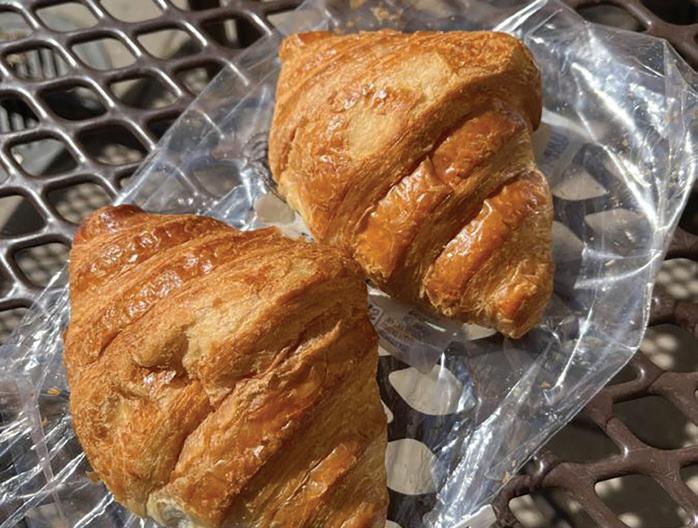 By McKenna Rausch, Milena Rodriguez and Jasmine Tabrizi
By McKenna Rausch, Milena Rodriguez and Jasmine Tabrizi


Web
C MAGAZINE
EXCLUSIVES
these stories and more at cmagazine.org
May 2023 • Volume 11 Edition 5
thanks TO OUR SPONSORS
Alan Cummings
Anna Hagan
Annette and Tom King
Bob Cooper
Carrie and Chris Daniel
David Sheaffer
David Schmitt and Lettie Bien
Ed Dunn
Ellen and Victor Meyerfreund
Emma Joing
Eugenie Van Wyden
Hannah Cho
Henderson SFIS
Isabelle Hau
Jacqueline Lo
Jieun Shin
Jill Keefe
Joe McGinnity
John Cooper
Judy Cummings
Kate Freeman
Laura Prentiss
Liza Baskind
Lorna Thornton
Marice Tzeng
Mary Meiser
Maura McGinnity
Melissa Caren
Michelle Cooper
Peggy Morrison
Sandra Gifford
Sarah Markesky
Sotnick Family
Sunghyun Hwang
Susanna Lee
Suyan Ling
Sydney Rusay
Tal and Yoav Samet
Tao Chen
Taylor Family
The Bakhash Family
The Chen Family
The Coulson Family
The Hong Family
The Kuartz Family
The Morrison Family
The Oda Family
The Papp Family
The Rodriguez Family
The Rosso Tabrizi Family
The Samet Family
The Sethi Family
The Tzeng Family
Victura
Vivian Kalik
Yuxuan Ruan
staff
Editors-in-Chief
Scarlett Cummings, Siena Dunn, Brooke Hudacek, Zeke
Morrison
Managing Editors
Sarah Bakhash, Lily Daniel, Mary Henderson, Anika Raffle
Online Editor-in-Chief
Sarah Sheaffer
Social Media Manager
Jake Papp
Staff Writers
Creative Directors
Esther Chung, Martina Meyerfreund
Business Manager
Saachi Nagar
Adviser
Brian Wilson
Table of Contents
Alma Samet
Jeslyn Chen, Kaila Chun, Evie Coulson, Audrey Guo, Olivia Hau, Isaac Hillesland, Eunchae Hong, Julie Huang, Miya Joshi, Wendy Li, Anna Markesky, Caitlyn Oda, Uri Ponte, McKenna Rausch, Milena Rodriguez, Ella Rosenblum, Alma Samet, Kellyn Scheel, Willow Steele, Jasmine Tabrizi, Kylie Tzeng, Casey Walters
Cover



Scarlett Cummings, Esther Chung, Siena Dunn, Brooke Hudacek, Martina Meyerfreund, Zeke Morrison
Illustrators
Sabela Chelba, Esther Chung, Miya Joshi, Wendy Li, Zeke
Morrison, Caitlyn Oda, Kellyn Scheel Letters to
the Editors
The C Magazine staff welcomes letters to the editors but reserve the right to edit all submissions for length, grammar, potential libel, invasion of privacy and obscenity. Send all letters to eicscmagazine@gmail.com or to 50 Embarcadero Rd., Palo Alto, CA 94301.
Table of contents


culture 11 8 6 Summer Snacks 40 Senior Playlist 30 Capping Off The Year 27 Under the Sun 38 Moving Melodies 16 A Midsommar Day’s Dream More Than Plastic 20 Acknowledgement to Action 24 arts Music Same Moon, Same Stars 33 Super Gloom to Super Bloom 10 Years of C Mag The Final Call 34 Which Taylor Swift Era Are You? 42
S Orange


ummertime nacks
C Magazine puts its own summer twist on two popular recipes
As summertime rapidly approaches, C Magazine has taken two popular recipes, lemonade and brownies, and put a fun summertime spin on their flavors. From bright and refreshing orange blossom lemonade to earthy and chewy matcha brownies, these recipes will surely make any summer day even brighter!
Blossom Lemonade
Drink Mix:
2 cups water
¾ cup lemon juice (~4 lemons)
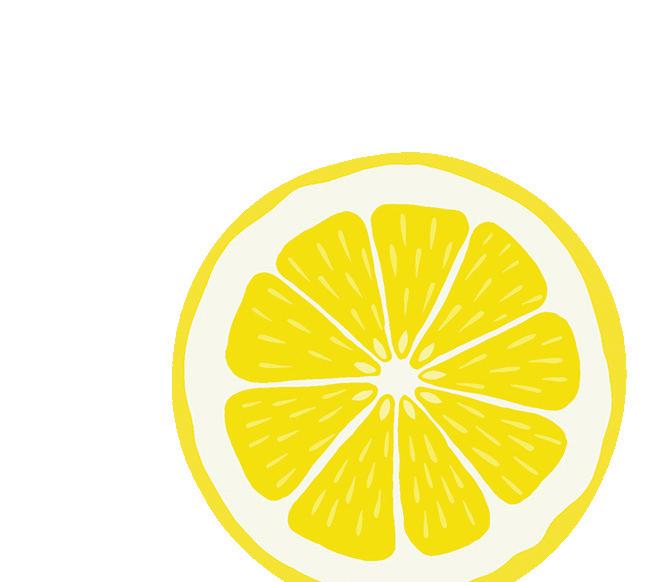

Ice
Simple Syrup:
¼ cup water
¼ cup sugar
1 tablespoon orange blossom water
1. To make the simple syrup, stir together the water, sugar and orange blossom water over medium heat until the sugar dissolves completely.
2. To make the drink mix, combine the lemon juice, water and as much ice as you would like in a large pitcher.
3. Mix in the simple syrup to taste.

6 • cmagazine.org
Matcha MOchi Brownies
Brownie Layer:
½ cup unsalted butter, melted
2 tablespoons matcha powder
½ white chocolate chips
1 ½ cup brown sugar

1 cup flour
3 teaspoons baking powder

1 egg
Mochi Layer:
1 cup glutinous rice flour (plus extra for dusting)
½ cup sugar
1 cup water
1. Preheat oven to 375°F.

2. In a medium-sized bowl, whisk together the sugar, egg, matcha and butter until smooth.
3. Mix in the flour just until it is fully incorporated and the mixture is smooth.
4. Fold in the white chocolate chips until they’re evenly distributed throughout the batter.
5. In a separate medium-sized, microwave-safe bowl, stir together the rice flour, sugar and water until smooth.
6. Place a damp paper towel over the bowl and microwave it for two minutes.
7. Mix the mochi mixture to reincorporate all of the ingredients. Then, place the bowl back into the microwave for another two minutes.
8. Dust a clean work surface with rice flour and turn your mochi mixture out onto it.
9. Use a rolling pin to flatten out the mochi until it’s about half an inch thick, and then set it aside.
10. Line an 8 in. x 4 in. loaf pan with parchment paper, and press about half of your brownie mixture into the bottom of the pan.
11. Slice mochi as needed to fit the shape of the loaf pan, and then layer it on top of the initial brownie layer.
12. Press the remaining brownie mixture on top of the layer of mochi, making sure to spread it out to reach all sides of the pan.
13. Bake the brownies at 375°F for 4050 minutes, or until the middle looks set and semi-dry. If at any point the surface of the brownies is browning too quickly, pull the pan out of the oven and cover it with aluminum foil, then put the brownies back in to finish cooking.
14. Optional: Add fresh fruit to garnish.


 Text and design by MILENA RODRIGUEZ and JASMINE TABRIZI • Art by KELLYN SCHEEL • Photos by MILENA RODRIGUEZ
Text and design by MILENA RODRIGUEZ and JASMINE TABRIZI • Art by KELLYN SCHEEL • Photos by MILENA RODRIGUEZ
CULTURE • 7
Known for her iconic pink wardrobe and expansive careers, the first Barbie doll hit the shelves in the late 1950s. The blonde, blue-eyed doll was equipped with a stylish outfit and an accessory or two, and would later become a widely famous doll in the hands of every young girl in America.
Over the years Barbie has expanded to other forms of entertainment. Movies were produced, doll houses were sold and young girls even aspired to look and act like their Barbie doll. Barbie had become the new beauty standard in pop culture decades before the era of social media. However, not all the effects of Barbie were positive. The beauty standards the doll portrayed, like a small waist and euro-centric features, were often unattainable and in reality, Barbie’s body measurements are completely unrealistic and impossible to naturally obtain, especially as a child.
Recently, the dolls have become more inclusive, reaching more communities and relating to more girls by having diverse skin tones, body types and abilities. With the same recognizable style, Barbie now inspires all kinds of girls to achieve their dream job and work hard. But how will the legacy of Barbie affect the new generation? Especially with the new movie coming out this summer and the skyrocketing increase of social media use, will Barbie’s negative impact on body standards only amplify?
Director of Student Services at Hillsborough City School District, Bhavna Narula, works with elementary and middle school-aged students focusing on mental health and social and emotional learning. She has experience with being a middle school counselor, administrator
and principal. Throughout her exten sive career, Narula has seen the negative effects of Barbie presented on students.


“We begin to see the impact of figures like Barbie starting in as young as third grade,” Narula said. “There is an emphasis on what they [students] look like, and at an age that is defined by trying to fit in, they try to fit in with the stereotypes that are perpetuated by what we see in the media such as Barbie.”
Similar to Narula, Paly junior An nalise Klenow disapproves of the beauty standard often set up for girls through Barbie and other media as it creates unreasonable expectations and low self-confidence.
“It’s not uncommon to see body types like Barbie’s, because it’s not just in Barbie dolls,” Klenow said. “It’s also in cartoons, and it’s very exaggerated.”

The negative effects of Barbie can be reflected in real life especially on school campuses as children exposed to one body type can ridicule others for not fitting in with their body standards.

“We have unintentionally raised girls on a steady diet of what an ideal body shape is, an image that is very white-cen tric,” Narula said. “Toys like Barbie have


“She embraces feminity in a really positive way.”
- Annalise Klenow, 11
8 • cmagazine.org
How Barbie’s hyper femininity and changing brand image can impact children’s views for better or for worse
tive way,” Klenow said. Barbie can also inspire children to set high goals for themselves and persevere. With these aspirations, the widespread culture of a “Barbie life” can actually promote a healthy mindset, contradicting the stereotype of needing to rely on a man, with respect to their future.



“I do think that Barbie leads a very admirable life. That’s one great thing we can take away from Barbie, is her drive and motivation and her problem-solving abili - ties,” Klenow said. “Ken was never the goal.”
However, Barbie still portrays an unrealistic beauty standard which is problematic for young children during their developmental stages.
“Through my professional career, I
Text and Design by SARAH BAKHASH and SAACHI NAGAR Art by RENNY ARGAST and ESTHER CHUNG
have seen issues with eating disorders that can connect to the societal image of what girls should be, and is especially harder on students of color,” Narula said. Recently, Mattel has tried to brand its dolls with more inclusivity to reach out to a wider audience.
“For white students all they see around them in media are mirrors, they can easily flip to any channel or streaming platform and can see people who look like them,” Narula said. “But for students of color, all they have are windows. Those kids don’t see people who look like themselves in the media, so Barbie is responding to that.”
Some still speculate that this newfound inclusivity is just a business scheme to appeal to more markets. Regardless of whether Mattel’s intentions are pure, the outcomes can still be productive.
“When your market is becoming more diverse, it forces you to become more inclusive,” Narula said. “There are more diverse models of Barbie where different cultures and abilities are represented, so I think that’s a step in the right direction.”
The rebranding of the dolls has created an image of Barbie that links to encouragement and healthy advice.
“Barbie wants to help people, so to have everyone look the same, it
doesn’t make sense,” Klenow said. With the new Barbie movie coming out in July of 2023, the past and current controversies of Barbie as well as soci ety’s image of what the “perfect wom an” should be are popping back into the spotlight. Although there can be nega tive effects of Barbie, Mattel seems to be consciously working on how to promote diversity within the Barbie community.
“Barbie is really good at enforcing strong female friendships and embracing femininity in a positive way,” Klenow said. “But there’s still a lot more that could be done.”

“We begin to see the impact of figures like Barbie starting in as young as third grade.”
- Bhavna Narula
CULTURE • 9
The of Barbie

The first Barbie was made in 1959. In 1965, Mattel came out with a Slumber Party Barbie that came with a “How to Lose Weight” book that simply advised girls not to eat.


Teen Talk Barbie hit the shelves in 1992. It features two girls talking about shopping and how “math class is tough,” which further solidified gendered stereotypes that detered young girls from STEM.
1960s 2010s 2020s
In 2023 Mattel partnered up with the National Down Syndrome Society to design a doll with Down Syndrome to increase diversity and make all girls feel represented.

In 1975, Mattel produced a Growing Up Skipper Barbie where the consumer could rotate Skipper’s arm and she would grow breasts.


1970s 1990s
Barbie Life in the Dreamhouse, a TV show, was produced in 2012. This was the first web series based on Barbie that Mattel produced.




10 • cmagazine.org
10
YEARS C MAG of
On October 19, 2012, The Campanile released their first-ever magazine. The first issue of “The Campanile’s Magazine,” an extension of Paly’s increasingly popular newspaper, was 20 pages long with 10 feature stories, and covered topics like style, food and culture. It was an instant hit. 10 years later, the 64th issue of C Magazine (the one you’re holding!) spans over twice that length, placing a greater emphasis on relevant cultural stories and multimedia content.
How did the idea for C Magazine come about? Back in 2012, a group of students had repeatedly approached Paly journalism adviser Esther Wojcicki asking to write feature stories, but The Campanile didn’t have a category that these stories could fit neatly into.
“So I made a suggestion to them like, ‘Why don’t you just
start another magazine?’” Wojcicki said. “They all thought it was a great idea.”

Expanding into a magazine gave Wojcicki’s students the space to both write about creative topics and get creative with design.

“One of the first articles that they wanted to publish— which of course I thought was a little crazy, but everyone else loved it—was an article about how to braid your hair,” Wojcicki said. “They did a lot of different types of braiding and took pictures and did a whole article on it, and it was super popular.”
In this final issue of the 11th volume of C Mag, we’re looking back on our first 10 years of visual storytelling—retracing our steps to how we’ve evolved into the publication we are today.
Celebrating a decade of visual storytelling
CULTURE • 11
Photo by LILY DANIEL and AUDREY GUO
vol.
“One story that I really enjoyed writing was the ‘Empowerment Education’ story which highlighted the Best Buddies club at Paly. As a member of the club, it was really great getting to interview the students I knew well from Best Buddies and hear more about their interests. Interviewing a variety of students and getting to hear about their lives gave me the chance to meet even more students in Best Buddies...I remember that after the story came out, new people joined the club as well, which was really powerful to see.”
2018
“One of the first articles that they wanted to publish— which of course I thought was a little crazy, but everyone else loved it—was an article about how to braid your hair. They did a lot of different types of braiding and took pictures and did a whole article on it, and it was super popular.”

Vol. 4 • Issue 3

“My favorite story that I worked on was called ‘Slipping Through the Cracks’ and it addressed the experience of navigating our school system with learning differences...We took a creative approach on how to capture learning disabilities visually, utilizing tangible representations for concepts of time and pressure.”

FRIDA SCHAEFER BASTIAN,
On ‘This is the End,’ “I think one of my favorite [memories] was at the end when Maya, Maya, Clara and I (Editors ‘15-‘16) did our final story together, including taking these photos for the story that make it look like we are holding up the text on the page. This was such a fun way to end our time as editors.”

FRIDA SCHAEFER BASTIAN,



1 • issue 1
vol. 1 • issue 5
Esther Wojcicki, Adviser
Rosa Schaefer Bastian, EIC
Vol. 4 • Issue 6
Vol. 6 • Issue 1
EIC 2015-2016
EIC 2015-2016
12 • cmagazine.org
C Mag’s first cover stars then-junior Cathy Rong, captured by Caroline Martignetti.
Meet the EICs




“I am now a graphic designer for Adobe’s Events Team. C Mag honestly gave me so many skills at such a young age that I am certain I would not be as successful as I am now if I hadn’t been involved in it. My whole major & capstone were clearly inspired by my love for C Mag. When I went to college I realized how passionate I was about design and I really have C Mag to thank for that.”
“One of [the stories] I’ve always been really proud of was a story about addiction and its portrayal in the media (‘The Face of Crisis’). We got some really great interviews for that, including this photographer I reached out to who did a photo essay series for The New York Times on opioid addiction. He let us use his photos, which I was really happy that he let us do that.”

“One challenging story that we worked on as EICs was the ‘Big Business is Watching’ story… When we got the magazine back, we were quickly told that there was a typo in the title on the cover which was really upsetting for all of us, especially the group that had worked so hard on the cover story. Our mistake overshadowed their hard work. We ended up taking full responsibility.”


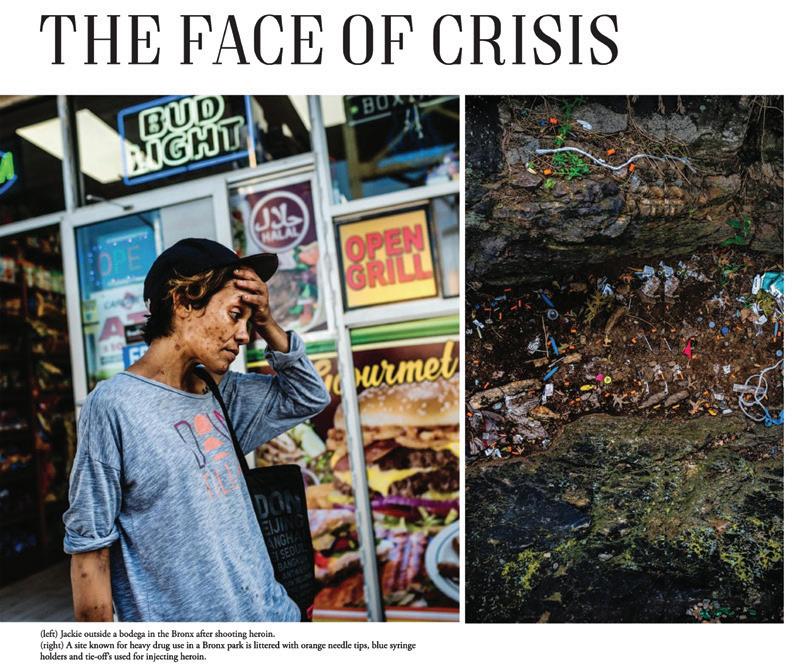

Vol. 7 • Issue
Vol. 7 • Issue
4
2
Rosa Schaefer Bastian, EIC 2018-2019
HANNAH DARBY, EIC 2017-2018
Ashley Guo, EIC 2019-2020
CULTURE • 13
Text and design by LILY DANIEL, AUDREY GUO and ANIKA RAFFLE Photos courtesy of PALY JOURNALISM ARCHIVE
Fixed version!
Vol. 9 • Issue 4
“A story that challenged me as an interview er and writer was ‘The 51%’, which was about women in government. This story was challenging first because we had to reach out to and interview high profile women in government which was quite a nerve-racking process. We also had the challenge of trying not to fall into writing about women in government like the issue of a lack of female representation in government could simply be solved [with a] ‘girl boss feminism’ approach.”
EMma Joing, EIC 2021-2022
Vol. 8 • Issue 2



Vol. 9 • Issue 5
On “This is Not a Drill”: “I once had an interview at an eco-community house that had a collective of scholars and families that lived together and led a pretty radically eco-conscious lifestyle... My interview with them was unlike any I have ever had because the only time they agreed to be interviewed was over dinner at their house which provided a really personal setting and allowed us to even tour the house. It really was like a conversation and discussion, we just happened to be recording.”

Kimi Lillios, EIC 2020-2021
“[‘No Longer the Sport of Kings’] was the one story that I wrote, designed, and photographed all by myself, which was crazy. I was really interested in the surfing dynamics in the water [and] how those dynamics played into the localism culture of surfing, and how a lot of the locals that had been surfing at these beaches for 30, 40 years were being really aggressive towards new surfers, and just how the whole dynamic in the water was changing.”

Alexa Gwyn, EIC 2020-2021


14 • cmagazine.org
“IT’S ALWAYS FUN TO TELL PEOPLE I SURF, BECAUSE NOBODY EXPECTS A PERSON OF COLOR TO BE A SURFER.” - TRE’VON BOYKIN
Between Sept. 19 and 22, C Magazine installed a black chalkboard on campus inviting students to respond to the prompt, “BEFORE I GRADUATE…” By the end of the day, the board was covered with dozens of rainbow-colored, handwritten phrases that revealed the varying hopes and dreams of Paly students.

What do you want to do before you graduate?
“My favorite story I worked on was the story about dissociative feminism (‘Desired Dissociation’). The topic was something I was personally super interested in and so writing the article

looking ahead

“I think for the future of C Mag we really want to value inclusivity, diversity, and creativity in our magazine. I really want to continue to foster an environment that allows students to step outside their comfort zones and create something that they’re super proud of.”
SCARLETT CUMMINGS, CURRENT EIC

“The content has gotten better, every year has gotten better and better...it’s evolved into an absolutely great publication. And needless to say, I’m very proud of that.”
Esther Wojcicki, Adviser
vol. 11 • issue 1
vol. 10 • issue 5
CULTURE • 15
A Midsommar Day’s Dream
A traditional Swedish holiday and what it means to a Paly family
he changing of the season is celebrated
man at Paly said, about the misconceptions that arose about this holiday after the release of the horror film. “We do
Lagerblad celebrates the Midsommar fes tival with her family every year and it remains an important part of her culture and summer traditions.

“Midsommar usually takes place around the height of summer, which is when it’s brightest,” Lagerblad said.















“And because Sweden is a
“I promise we do not burn people,” Elsa Lagerblad, a fresh
Text and design by ISAAC HILLESLAND and URI PONTE Art by ESTHER CHUNG • Photos courtesy of SUSANNA LAGERBLAD
Right: Young Lagerblad and her family dancing around the maypole in
“I was just having a great time in the sun in the summer and appreciating nature. It was really nice.”
- Elsa Lagerblad, freshman
the sun is high, everyone’s just happy. It’s just about having a good time.”
Susanna Lagerblad, Elsa’s mother, is from Sweden and works at a Swedish school for kids. She has had a lot of experience with Midsommar and its traditions, including some of the legends that come with the holiday every year.
“Midsommar night is magical and a bit superstitious,” Susanna said.“The line between the real world and the superstitious world is really thin during Midsommar night.”
Ancient superstitions still exist around such important old holidays like this. Susanna cites one of women being able to see the
“Women could go out and collect different kinds of flowers and put them under their pillow,” Susanna said. “And then in dreams they would see their future husbands.”
Besides the ancient superstitions, Midsommar celebrations traditionally involve a communal dance around the Maypole, a long pole which is put into the grass, where various celebrations commence.

“We make a pole out of birch leaves, branches and flowers that we find in the area,” Elsa said. “It usually is a cross looking thing with two circles and we make little flower crowns and we sing songs.”
Celebrations around the maypole usually involve dances, some of which are very playful
“The dances are spectacular,” Susanna said. “We have one that’s called the frog where we dance around the pole and pretend to be frogs.”
Another important component of a Mid sommar celebration is the large meal with traditional dishes, typically eaten with family and friends to celebrate the season.
“We usually have a big dinner and we in vite neighbors and family,” Lagerblad said. “We love to eat pickled fish, pickled herring specifically, eggs, potatoes and sausages, which is traditional Swedish food.”
No Midsommar feast is complete without strawberries, which are used to make desserts like a strawberry cake to finish up the feast. This aspect of the meal is particularly special considering the small amount of time in the summer you can get them in Sweden.
“We only have strawberries for about four weeks in Sweden,” Susanna said. “And it is always this question: ‘Will they be ready for Midsommar?’”
The opportunity to hang out with family and friends to enjoy a fun dance or tasty meal is something that makes traditional holidays such as Midsommar so special.
“It’s just so nice to be able to have everyone together for dinner and get to catch up with people that you haven’t seen in so long,” Elsa said. “I love it.”
With all the summertime joy that comes with the celebration of Midsommar, also comes a sad remembrance that days are only going to get darker.

“You know from this day on it’s going to get darker again, so it’s also a tiny bit sad, because this is the brightest day,” Susanna said.
Though there is a melancholic undertone to the celebration for Swedish people, the event remains mostly joyous and optimistic.
“It’s like a turning point,” Susanna said. “After Midsommar, we go towards brighter times.”
For Elsa, the memories of these fun summer celebrations that are such an important part of her family and culture will be with her for the rest of her life. In particular, her fondest memories of Midsommar involve coming to Sweden to celebrate with her family
“When I was little, my family and I, cousins, aunts, uncles, we all just got in a circle and danced around the [maypole] and sang songs,” Elsa said. “It was just a really good time, and I remember that the sun was shining and grass was on my feet. I was just having a great time in the sun in the summer and appreciating nature. It
St. Nikolaus Day
Memories of a German holiday tradition
Niklas Hagstroem, a senior at Paly, has fond memories of celebrating the German Saint Nikolaus (or Nicholas) day around Christmas time every year. Besides just the delivery of presents like in the US, the celebration involves putting a boot out for Saint Nikolaus to put goodies into.
“Traditionally it’s chestnuts, but nowadays it is just any present,” Hagstroem said.
The playful nature of this tradition continues to enchant Hagstroem.
“It’s pretty whimsical,” Hagstroem said. “I got to say the boot is a nice novelty.”

One particularly amusing memory that stands out to Hagstroem, was when his mother used this tradition to encourage him to keep learning their cultural language.
“I remember my mom (as Saint Nikolaus) put a letter in the boot saying, ‘no more presents if you don’t learn German’ so I remember thinking ‘oh no I’ve angered Saint Nikolaus,’” Hagstroem said. “That was pretty traumatizing.”
There are a lot of tasty foods eaten as part of these celebrations, but one stands out partic
CULTURE • 17
CELEBRATINGSENIOR YEAR
Paly senior traditions: both past and present
Senior year is filled with both old and new traditions and is the last time to make high school memories before stu dents begin new paths in life. The amount of traditions for seniors specifically has increased and changed drastically over the years.
Wearing camouflage pants has become a staple of senior year, from the first day of school to various spirit week days, events and football games. Senior elimination has developed pages of rules throughout its time, along with different challeng-

stress of college applications and the preparation for the next chapter in life is persistent, Paly students have always tried to make it fun through their various traditions. Each student and staff has their own opinion of these Paly traditions including which ones are the best and which ones aren’t needed anymore.
What are your thoughts on Paly senior traditions?

“I think Paly traditions are a lot of fun, it gets everyone together and it’s sort of like a bonding activity. There’s lots of photos taken and a lot of memories created through these traditions.”
“I am strongly against traditions that are used to demean other students or the community. I love having a sense of wholesome community where we can have some fun and enjoy our last year.”
-Yasmin Friedrichowitz, 12 “I am grateful to go to a school with so many traditions that a lot of people participate in. It builds a stronger community and is a lot of fun. The school and grade spirit of Paly is why I am going to be so sad to leave next year.”
-Johannah Seah, 12
-Sami Lee, 12

18 • cmagazine.org
What is your favorite senior year Paly tradition?
“Spirit week [is my favorite Paly tradition] because everyone is able to get creative with their clothing.”
-Caroline
Mostofizadeh, 12

“Quad Day (extended lunch with games and music)[is my favorite tradition] because it was truly fun and a great way to celebrate Spring. I also loved the rejection wall for college admissions because it was good to be vulnerable and also joke around some (e.g. letters from Hogwarts and Neverland).”
- DJ Shelton, History Teacher
“My favorite Paly tradition is when seniors wear camo pants and hang out on the senior deck during the first day of school. It’s so much fun to see our grade come together and continue this tradition.”
- Olivia Hau, 12


What is your least favorite senior year Paly tradition?
“I have loved my four years at paly and I love most of our senior traditions but I feel like Senior sweatshirt day can really reinforce the idea that only some paths and colleges are acceptable to be proud of. It can be isolating to those whose future isn’t a well known four year college.”
-Sami Lee, 12
“Egg Wars [is my least favorite tradition] - so bougie, so wasteful, such a horrible abuse of public and private property.”
-Eric
Bloom, Economics Teacher
Text and
EUNCHAE HONG • Art
JESLYN CHEN and ESTHER CHUNG
design by KAILA CHUN, EVIE COULSON and
by
CULTURE • 19
ATO C T I O N
Whether it be a verbal statement or sign posted on a building, the presence of indigenous land acknowledgements is becoming far more commonplace. A land acknowledgement is a formal statement that the land being used by current occupants was previously inhabited by indigenous peoples.
While this acknowledgement has benefits such as bringing awareness to the issues, it raises questions regarding the value of these acknowledgements. Many question whether creating a land acknowledgement is actually productive. This also leads people to wonder what more needs to be done to obtain some form of justice for these indigenous communities who had their land stolen from them.
For starters, it is important to take into account that land acknowledgements themselves play a crucial role in getting the conversation regarding past injustices to indigenous communities started.
“Acknowledging historical injustice and spending the time to acknowledge the real-
ity of the situation of where we are, as well as protecting the authorization of the people who have given us so much through their land is tremendously important,” Dmitrius Rodriguez, a corpsmember working with Grassroots Ecology, said.
Grassroots Ecology is a local organization working to engage and educate the public about restoring local ecosystems, and within that process, Rodriguez believes it is vital to learn from indigenous communities.

“We are so disconnected from traditional ecological knowledge because of capitalism and colonialism,” Rodriguez said.
Along with a need for traditional ecological knowledge to be restored, there is also a large need for the public to be open to hear from new perspectives.
“Doing a land acknowledgment, and it has been continuously said over and over, isn’t enough,” Rodriguez said. “It is just the start of creating an educational environment for people to learn more and hear from indigenous voices.”
Specifically, there is great significance
20 • cmagazine.org acknowledgement
Beyond acknowledging the history of indigenous tribes, listening to those within the communities provides an opportunity to spark change
Chairwoman Charlene Nijmeh sitting at the Muwekma Ohlone Tribe’s flag raising ceremony in Milpitas. Photo Courtesy of Mylene Stolpe.
that comes along with hearing voices within indigenous communities because of tribes’ deep history of being taken advantage of. There is also very little awareness amongst the general public about the current issues occurring.
“Learning history from diverse perspectives is very important,” Rodriguez said. “Any type of history you are learning has a bias to it and getting more perspectives is the only way that you can acknowledge bias.”
One local tribe in particular, the Muwekma Ohlone Tribe, is still facing the struggles brought on by the dark history of western expansion.
According to the Muwekma Ohlone Tribe’s website, before western influence, the Muwekma Ohlone people resided in counties including: San Francisco, San Mateo, Santa Clara, Alameda, Contra Costa, parts of Napa, Santa Cruz, Solano and San Joaquin. However, from 1776 to 1836, they were influenced through a process of westernization in social, religious and cultural areas, by the Missions’ Dolores, Santa Clara and San Jose.
Today, the Muwekma Ohlone Tribe consists of over 600 tribal members which is a significant decrease compared to the estimated 300,000 native people before European contact, according to a 2023 article in the Stanford Daily.

“It is important to not perpetuate the cycle of projection onto these groups of people who have a voice for themselves” Rodriguez said.
To reduce this cycle of projection, one where the history of
indigenous people has been consistently wrongly told, hearing from individuals within the Muwekma Ohlone Tribe is crucial to accurately finding out what needs to be done for those within the community. To accomplish this, chairwoman of the Muwekma Ohlone Tribe, Charlene Nijmeh, speaks on current events.
“I always say that [land acknowledgements] are a first step but more needs to happen, especially federal acknowledgment,” Nijmeh said.
By saying “federal acknowledgement,” Nijmeh is referring to the process of getting the tribe’s federal recognition restored.
“We need everyone’s support, and that is what is important to Muwekma,” Nijmeh said. “Getting our status restored and
having a land base where our youth can be protected from being gentrified from our homeland.”
The process of federal recognition is one where the United States government recognizes the rights of a tribe to exist as a sovereign entity, referring to the right for them to govern themselves. This has been an undertaking the Muwekma people have been pushing towards for over 40 years.
“It is as simple as Deb Haaland, the Secretary of the Interior, writing a letter and saying ‘we made a mistake and we’re going to correct that mistake and put you back on the 1978 list of recognized tribes,’” Nijmeh said.
The process is, however, overcomplicated by many politicians causing slow progress in the direction towards recognition. The process of recognition has had many twists and turns for the Muwekma tribe.
On May 24, 1996, the Bureau of Indian Affairs (BIA) confirmed that the tribe existed between 1914 and 1927. However, they failed to determine that the community existed between 1927 and 1985, even with evidence demonstrating otherwise.
Since then, Nijmeh has been attempting to work with government representatives towards recognition but has faced issues along the way. In particular, they have struggled with miscommunications regarding gambling and sovereignty.
“What [state representatives] are asking us to do is give up a piece of our rights for future generations,” Nijmeh said.
CULTURE • 21
“I always say that [land acknowledgements] are a first step but more needs to happen, especially federal acknowledgment.”
- Charlene Nijmeh, Chairwoman of the Muwekma Ohlone Tribe
The Muwekma Ohlone Tribe’s flag held up by Milipitas employees at flag the raising ceremony. Photo Courtesy of Mylene Stolpe.
Text and design by MARY HENDERSON • Art by KELLYN SCHEEL
Although, current council and administration within the tribes have no involvement with gaming, they believe that it is within their right to allow future generations to make the decision for themselves regarding economic development.
“You stole our land, you ripped us from our language and culture,” Nijmeh said. “Now you want to take more away from us.”
With these frustrating complications, Nijmeh looks to younger generations as a driving force for advocacy and change.
“They are the loudest out there saying, ‘pay attention to this group that has been struggling for 40 years to get their status restored,’” Nijmeh said.
This advocacy is mostly due to fearlessness of the young people speaking out.
“They are the gamechangers nowadays,” Nihmeh said. “They see what’s happening and they see the injustice and they are speaking out because they feel like they have nothing to lose.”
This rise in awareness among the
youth may lead one to question the power that an individual can have on such a daunting task, Jonathan Michelangelo Lockwood, spokesperson for the Muwekma Ohlone Tribe, suggests.

“They [youth] are actually more powerful than lobbyists because their voices are stronger than any dollar
You Are On Indigenous Land
amount when we unite and stand up for a cause, especially like we’re seeing in the Bay Area,” Lockwood said.
Furthermore, events and protests are being held within the Bay Area in support of the tribe.
“It has been really impressive to see how much the community has come together and it has really been led by the youth, the students that really understand these issues and the need for the Bay Area to right the wrongs of the past,” Lockwood said. “Because really, to deny Muwekma is to deny the California genocide that was led by the California government.”
Peter Burnett, the first elected governor of the state of California, commanded to wage a war of extermination until all indigenous people were wiped out by signing the Act for the Government and Protection of Indians in 1851. This piece of legislation played a crucial role in the California genocide, in which thousands of indigenous Californians were killed or enslaved by white settlers during
The Federal Recognition Is Broken!
Process
22 • cmagazine.org
“If they’re inviting the public to come out, that is an incredible opportunity to learn and really shows that you care about the issues.”
- Dmitrius Rodriguez, Grassroots Ecology corpsmember
Muwekma Ohlone leadership following the land acknowledgement at the 2023 Santa Clara University Powwow. Photo Courtesy of the Muwekma Ohlone Tribe.
the Gold Rush.
“As students are learning about this, they are beginning to say ‘no more,’” Nijmeh said. “We need to have discussions out in the open so we all know what is happening.”
Discussions and more open education regarding about indigenous history is especially important while learning about the truth.
“There is still room to learn more,” Rodriguez said. “There are so many people that are willing to teach you more and those people will not be around forever. There is just a wealth of knowledge and we’re slowly moving into a time where we
might not have access to that same type of knowledge. It’s the same idea over and over again, where marginalization increases inequality and inequities.”
Getting involved and working directly with indigenous tribes is an essential role in one’s continuous education and awareness of issues within marginalized communities.
“A lot of local Bay Area organizations would love to have young people spend time with them,” Rodriguez said. “If they’re inviting the public to come out, that is an incredible opportunity to learn and really shows that you care about the issues.”

Scan Here to Visit the Muwekma Ohlone Tribe’s Website Recognize

US
CULTURE• 23
CULTURE •
Super GLOOM Super BL M to
Radiant wildflowers explode across California
Have you ever wondered what it would feel like to be in one of Monet’s majestic landscape paintings?
It turns out you don’t have to travel to France to experience such a wonder! After multiple consecutive atmospheric rivers, California has emerged from five years of drought, and a dreary landscape dominated by brown hues, to an explosion of color.
Large stretches of California are blanketed with bright yellows, oranges, reds and blues, creating a wildflower kaleidoscope known as a “superbloom.” Satellite images even show the pops of color from outer space.
Judith Schwarz, a local environmentalist and horticulture expert with three decades of experience working with California’s native flowers, takes a step back to put this year’s superbloom in context.
“The first thing you should know is that California is very blessed [because] we’re the number one [region] in the world with the most annual flowers,”





Schwarz said.
“That’s something to be proud of.”
According to Schwarz, the super bloom was no accident. Coming off of a drought, California was fortunate to get ample rain over the course of the winter.
“Now everything is exploding because the elements are just right,” Schwarz said. “The weather is not too hot and there is moisture in the soil.”
No single flower is responsible for the super bloom. Many varieties contribute to the diversity of colors and sizes.

“The California poppy, known as Eschscholzia californica, has bright yellow blossoms,” Schwarz said. “Some [wild flowers] are very tiny, others are larger. Another one is yellow with an orange center that blooms longer than the orange poppies. There are also Baby Blue Eyes that are really a true blue.”




However, nature’s show of lights doesn’t last long. Schwarz estimates that the wildflowers can show off their dazzling colors for up to two and a half months, but the flower’s longevity is contingent on the weather.
“There’s a clarkia that is amazing and in good soil can get about four feet tall,” Schwarz said. “The bees and hummingbirds love it. If we get hit by a heat wave, things will dry out faster so it really depends on the year.”
Jennifer Dirking, chair of Wildflower Ambassadors for the California Native Plant Society of Santa Clara County, works to raise awareness of the importance of native plants and the critical role they play in building back ecosystems that support bees, birds and oth-
er wildlife.
“California is one of the biggest biodiversity hotspots in the world,” Dirking said. “Superblooms are a great way to raise awareness [on biodiversity]. People see the diversity and ranges of our plants, and they learn that these are really delicate ecosystems.”
Beyond the beauty and wonders of nature, there are positive ripple effects that native plants have on an ecosystem. Insects rely on native plants as their primary source of food and larger animals rely on the insects. Nature and living creatures are interdependent.
“It’s important to build back and restore ecosystems,” Dirking said. “Let things eat your plants. It takes a lot of caterpillars to feed a chickadee. If you put on your chickadee eyes and walk through our neighborhoods you’ll see that there are no native plants to feed them. There is only one native garden every three or four blocks.”

If you aren’t able to experience a superbloom this season and don’t own a Monet painting, you can take a few simple steps to create one in your backyard. The key is to find plants that are native to California and require little water.
“What people don’t realize is that they can have all that beauty in their own yard,” Dirking said. “The average yard is really a wasteland. It has a lawn that became popularized by the imperialists in England in 1842 and times moved on since then. It’s time to look at the beauty that we have in the hills and nature around us and literally grow some of that where we are.”
Text and design by JESLYN CHEN and ANNA MARKESKY•
24 • cmagazine.org
Art by JESLYN CHEN • Photos courtesy of HAZEL WIJSEN






CULTURE • 25



under the sun
In almost every medium, too much sunlight can ruin an art piece, but what would happen if it was a part of the process itself?




ART • 27
Most art is made from the comfort of an indoor studio or covered enclave, away from the damaging heat and light produced by sunlight.
If hit by its rays for too long, many mediums including oil, acrylic, clay, and pastel will often show damaging effects through fading color and cracking textures.
However, there is one artistic method that uses these effects to its advantage. Sun printing, otherwise known as Cyanotype, is a 170-year-old camera-free printing process that utilizes UV rays and negative space to transfer photos onto fabrics and papers.

As spring and summer approach, the art style has gained newfound popularity due to its vibrant colors and seasonal dependency on sunny weather.
Paly junior Alice Brandenburg enjoys the more practical aspects of the medium, and how financially accessible the art style can be.
“If you see a cool design and you really like it, you can implement it into a piece of clothing that you make, and it’s a lot easier [than buying],” Brandenburg said. “It does take some time, but it’s a fun experience and you save money.”
With materials totalling to just under $20 Brandenburg and her friends were able to print on over ten articles of clothing, proving the economic benefits.
As a process, Cyanotype can also be more liberating than other artistic methods. Paly junior Renny Argast had the opportunity to experiment with the process at a pre-college program she attended last summer at the Rhode Island School of Design.
“It was kind of freeing,” Argast said. “I feel like a lot of art forms are very constricting and you have to think too much about all the things that you have to do, but we used natural materials like flowers and leaves, so it felt more spontaneous.”
Using natural materials is a common practice in Cyanotype and other sun printing methods. Sierra Mohr is a fiber artist based in Nevada City, California who specializes in eco printing, also known as botanical dying, a process similar to Cyanotype in which the natural colors and silhouettes of plant materials such as flowers, leaves, seeds, or bark are transferred onto fabric or paper.
“The first time I saw an eco-dyed item I knew immediately that I had to learn the process,” Mohr said. “I learned the basics and from there I dyed and dyed, experimented, purchased tutorials and books, and dyed some more.”
Mohr’s passion has continued to develop over the years, be-
coming her full-time career.
“At first I dyed scarves, then home accessories and repurposed clothing,” Mohr said. “Then I took it up a notch, creating one-ofa-kind garments, handbags and accessories.”
Although a fairly resistant art, there are certain conditions and elements that are able to hurt its appearance.
“The colors can be affected by many things, such as using various mordants, the time of the year the leaves were collected, and the weather conditions when collected,” Mohr said.
For example, a leaf collected in spring may produce an entirely different consistency and color than its summer counterpart.

“I love that the process cannot be completely controlled and that nature is providing the prints,” Mohr said. “The results are always exciting, and to me, feel like gifts from nature. Each piece is unique and one of a kind.”
Why Are Blue?
Blueprints
First invented by Sir John F. W. Hershel in 1842, the polymath needed a way to copy his notes. He figured out how to manipulate the hyposulphite of soda and iron salts, spreading the solutes over a page and observing their reactions to light exposure over time. This gives us the classic blue-tinted spreads we now know as blueprints.

28 • cmagazine.org
“Each piece is unique and one of a kind.”
-Sierra Mohr, Fiber Artist
“It was kind of freeing... it felt more spontaneous.”
-Renny Argast, 11
how to sun print:

material list: step one:
Print out your chosen image onto a transparency sheet to create a negative, and place it on chosen paper or fabric.
• White papers or articles of clothing (tote bags, tank tops, and t-shirts reccomended)


• Transparency sheets
• Sunlight-developed dye (cyanotype or SolarFast)
• Sponge brushes
step two:
Place the negative overtop the cyanotype and leave in direct sunlight for 10-20 minutes.
step three: step four:
Trace the section you wish to color with a pencil, then spread cyanotype on the stenciled area with a sponge brush in a dark room.* Make sure to place a C Magazine in between the layers of the shirt so the cyanotype doesn’t seep through, and wait until the material is slightly damp to the touch before progressing to Step 3.
*Ensure no sunlight enters the room suring Step 2, or else the cyanotype will start activating too early!
Rinse fabric to rid it of chemicals, then allow your piece to hang dry overnight in a dark room. In the morning, your Cyanotype project will be ready to wear!
Text
and design by ALMA SAMET and SARAH SHEAFFER • Photos by ALMA SAMET and SARAH SHEAFFER
ART • 29






30 • cmagazine.org 30 • cmagazine.org
.





CULTURE • 31 ARTS • 31
and KELLYN SCHEEL • Photos by ISA MORABIA, OWEN RICE, EMMA JOING and SOPHIA BAGINSKIS
ART
Text and design by MCKENNA RAUSCH and KELLYN SCHEEL • Photos by SOPHIA BAGINSKIS, EMMA JOING, ISA MORABIA and OWEN RICE

32 • cmagazine.org
Photos courtesy of GORDON PARKS FOUNDATION
Same Moon, Same Stars
The newly painted mural of Kimberly Teehee, created by cohort seven from the Social Justice Program of 2023, aims to depict Teehee’s life, values and goals, and a Cherokee Nations representative in Congress.
During a press conference, in which Teehee gave contructive feedback to the team before they finalized the mural, she mentioned the improtance of handprints, which symbolize Missing and Murdered Indigenous Women (MMIW), as well as women and children who have been taken from their family. She also mentioned that all the elements of the mural are equally important, and it is the collectiveness of all of them that tells a story.
 Text and design by ESTHER CHUNG and MARTINA MEYERFREUND • Photo by ESTHER CHUNG
Text and design by ESTHER CHUNG and MARTINA MEYERFREUND • Photo by ESTHER CHUNG
CALL The Final
As seniors head off on their post-high school paths, they reflect on their artistic journeys

cmagazine.org
34 • cmagazine.org
From cartooning to graphic designing, Yan contributes his skills to the Paly publications
Flipping through the various Paly magazines, one is sure to see various art pieces from different outsourced Paly artists. Paly senior, Alex Yan, enjoys giving back to the Paly community by doing art for publications, such as Viking and C Magazine.
“I always did art because I wanted to, but none actually had a purpose,” Yan said. “Now I have the chance to enhance the publications.”
Yan’s love for art started at a young age when he began reading cartoons, and it has blossomed ever since.
“I wanted to get better at drawing because I read all these comic books, and I really liked that style of ‘Calvin and Hobbes,’” Yan said. “I wanted to become a cartoonist.”
Although Yan’s art style has changed from cartooning to sketching and graphic design, his passion has not wavered.

“It’s really relaxing and therapeutic,” Yan said. “I like the feeling of seeing my art finished and feeling satisfied.”
Alex Yan Leena Hussein
As Yan’s high school career comes to a close, he plans to continue his art career in college.

“I researched publications [my college] had and I’d maybe join those or take higher level art classes,” Yan said.
Perhaps shockingly, Yan has been a selftaught artist up until this year.
“I never took an actual art class until now,” Yan said. “That’s kind of embarrassing as a senior.”
However, Yan didn’t let his lack of formal education in art hold him back, and now urges others to follow their artistic passions.
“I just want to say if you want to do art, you don’t have to take formal lessons,” Yan said. “You can learn from looking at other artists and being inspired.”
Dedicated to dance through her high school career, Hussein considers her options and opportunities in college and beyond
For countless hours, several days a week, Paly senior Leena Hussein practices multiple genres of dance at the Cubberley Community Center.
Hussein has had a long journey through the arts. She started with choir at age six, but in middle school, she realized her passions had changed and that’s when she discovered dance.

“I did a lot of sports growing up, but I wasn’t into them that much,” Hussein said. “I tried swimming, softball, soccer, gymnastics and everything wasn’t working out. I think I fit more of the performing arts side of things.”
Hussein focuses on multiple types of dance: ballet, contemporary and jazz. As a competitive dancer, Hussein is forced to balance her rigorous practice schedule and competitions with her academic, social and personal life.
“I go to dance, come back and do homework, then sleep whenever I can,” Hussein said. “It’s about prioritizing, making schedules and using preps well.”
With her crazy schedule, Hussein is thankful for her teammates.
“It’s not like other sports, where you’re either good at the sport or you’re not good,” Hussein said. “[Dance has] different levels and there’s not a set expectation, but you still get the team aspect.”
Since dance is a team sport, there is pressure to not let the team down.

“It’s very difficult on your body, [injuries] like pulling muscles and bruises occur, so there’s the physical aspect,” Hussein said. “There’s also a mental toll because since it’s a team sport, if you’re lacking or you don’t have skills that other people have, it’s stressful.”
Protecting herself both mentally and physically is important for dance.
“Your sport is literally just your body,” Hussein said. Despite the toll on her body, Hussein loves to dance and wants to stick with it past high school.
“I am planning to continue dancing through college because I think it’s such a fun and expressive way to release stress and maintain physical activity,” Hussein said. “I think I still have a lot more room for growth.”
ART • 35
Text and design by KYLIE TZENG and CASEY WALTERS • Photos courtesy of LEENA HUSSEIN, REED JADZINSKY, KATIE MCCLUSKEY and ALEX YAN
ART
Reed Jadzinsky
Jadzinsky uses ceramics to find relaxation and peace
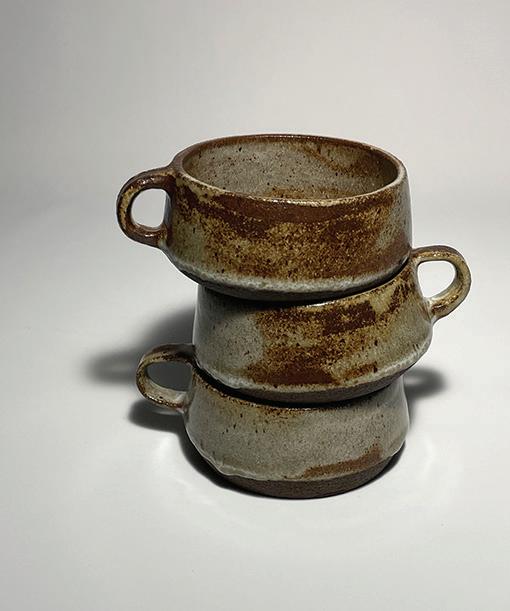


Senior Reed Jadzinsky is a talented graphic designer and ceramics enthusiast. As such, he’s practiced ceramics, specifically wheel throwing, for six years and graphic design for four.
In the sixth grade, Jadzinsky began to explore his interest in ceramics, first by taking a class at the Palo Alto Art Center. After that, he registered for ceramics classes in school, and he appreciates how ceramics lets him disconnect from academics.
“It’s very therapeutic,” Jadzinsky said. “It’s something that I definitely want to continue doing.”
Jadzinsky volunteers at the Palo Alto Art Center, assisting the loading and unloading kiln process, helping kids taking classes with their work, and keeping the studio tidy. In exchange, they give him volunteer hours and access to the adult studio.
“The adult studio is significantly better once you actually know how to throw because they have more clay and glaze options,” Jadzinsky said.
One of the struggles that comes with ceramics is dedi-
Katie McCluskey
cating time to work on his pieces, but Jadzinsky finds that this artschool balance problem actually has a few hidden upsides.
“Prioritizing [ceramics] over schoolwork actually helped me study later, because I’m more relaxed,” Jadzinsky said.
However, there are problems that come with spending so much time at the wheel. Jadzinsky often finds that his hands become dry, and his clothes are often covered in clay after he spends a lot of time working. However, Jadzinsky doesn’t let this stop him.
“For me, the benefits of what I get out of ceramics are worth it,” Jadzinsky said.
McCluskey turns yarn into clothes and meaningful gifts
While most teenagers might choose to spend their free time scrolling on TikTok, senior Katie McCluskey finds solace in her hook and yarn.
McCluskey’s creative process is organic and intuitive. She comes up with her own unique designs and makes anything from tank tops to blankets and bags.
“I just kind of wing it and hope that it works out,” McCluskey said. “I’ve done it for long enough to where I can make things work.”
While the freedom to create her own designs is exhilarating, it also presents some challenges.
“Sometimes it’s hard because you don’t have the right amount of yarn,” McCluskey said. “If you go by new yarn, and it’s the wrong dye batch, there are different colors.”
Despite these challenges, McCluskey has successfully created many beautiful and intricate pieces. One of her favorite creations is a blanket of 140 separate crocheted quilt-type

squares that she connected together.
“I didn’t follow a pattern, which I thought was pretty exciting,” McCluskey said.
McCluskey often gives her handmade works to friends as gifts, though it can be difficult to get the sizing right with clothing items.

“Sometimes my friends asked me to make them separate, random projects,” McCluskey said.
Looking ahead to college, McCluskey does not see her crochet hobby leaving anytime soon.
“I think in college, it could be just a nice thing to have sometimes, like a little reminder of home,” McCluskey said.
Her number one piece of advice for other crochet hobbyists is to expand their comfort zones.
“Go for it. Don’t worry about it looking ugly,” McCluskey said. “If it does, the worst thing you do is not wear or use it. And you just keep going until you make something cool.”
36 • cmagazine.org





ART • 37 • 37 Follow us on social media Instagram: @c_magazine Spotify: @cmagazine
MOVING MELODIES
Take a look inside your heart. Is there any room for me?
This is how 22-year-old indie pop star Pink Pantheress begins her hit song “Boy’s a Liar Pt.2.” Featuring Ice Spice, the song has now taken social media by storm, amassing over 106 million views. In the background of the 2023 music video, where the two stars sing and dance in various spots around New York, singer songwriter Ice Spice can be seen sporting an all white outfit and her recognizable curly orange hair.
“Boy’s a Liar Pt.2” spurred a TikTok trend in which fans perform Ice Spice’s signature dance moves. Music videos having a large impact in pop culture is not a new phenomenon. From the first music video that premiered on MTV, “Video Killed the Radio Star,” to videos like “Boy’s a Liar Pt.2,” music videos prove to be a way to engage and expand an artist’s audience.
“A lot of people see music videos through YouTube and that can give a different audience to a song,” junior Brody Rice said.
The arrival of music videos provided listeners with a new experience to enjoy their favorite artists. With new technology premiering in the 80s, artists were able to
enhance their music visually and give the viewers a sense of their personalities.
“We get to see who the artist is for the first time,” video production teacher Ed Corpuz said. “It’s another form of expression for the artist, so it was honestly just an extension of the song.”
Songs can be interpreted in many different ways, but music videos provide insight into the artist’s original intent when making the song.
“I like when from start to finish you feel like you have a new perspective on the song and music videos can provide insight into what the artist might’ve meant when they wrote it,” junior Ella Bishop said.
Music videos are not the only medium in which songs provide an extension of the story being told. TV shows and movies often intertwine music with the script and story to amplify the production.



“If you just think of ‘Stranger Things,’ you can’t have that show without music, for example take Kate Bush’s song,”
Corpuz said. “She already had a music video and then here’s ‘Stranger Things’ storytelling that really gives it a new life.”
These days music videos mostly allow an artist to connect to their fanbase and provide a new feel to their favorite songs.
“I think today’s music videos are very geared towards the fans and it gets us closer to the artist,” Corpuz said.
Nowadays, listeners around the world can tune into the live video premiere of their favorite songs.
“You’re just refreshing the page, seeing comments coming in from people all over the world in real-time,” Bishop said. “Knowing so many other people are watching it with you and seeing it for the first time, it’s such a crazy feeling.”
While music videos continue to be an integral part of the music industry, they have strayed from the storytelling aspect and now focus more on an appealing performance, where the artist may sing or dance in front of the camera.
“I think the difference now is that the performance is mixed in with the narrative,” Corpuz said. “So there’s a lot of that performance and less, I would say, storytelling, and I think that’s where this art medium is going.”
38 • cmagazine.org
How music videos have widened the influence of artists across the globe
I think today’s music videos are very geared towards the fans and it gets us closer to the artist.”
- Ed Corpuz
Music videos can provide an insight into what the artist might’ve meant when they wrote it.”
- Ella Bishop, 11
Released in 1980 as the first music video featured on MTV, The Buggles’ “Video Killed the Radio Star” paved the way for future artists. Not only did this music video popularize the song itself, but it also inspired musicians to make music videos of their own. Record companies quickly caught on to the song’s traction, and began to use music videos as a marketing tool.

Micheal Jackson released his music video “Thriller” in 1983, and went down in history for its film-like production style and iconic dance moves. It continues to remain highly influential in our current music and culture. The 13-minute video posed more as a short film than a music video— amassing over 149 million views.




Fast forwarding 35 years, Childish Gambino’s 2018 video, “This is America” directed by filmmaker Hiro Murai was controversial yet empowering for many individuals. The frames, packed with visual references to racism and Gambino’s erratic dancing, changed how people viewed music videos and their creative capability.



 Text and design by MIYA JOSHI and JAKE PAPP • Art by SABELA CHELBA and MIYA JOSHI
Text and design by MIYA JOSHI and JAKE PAPP • Art by SABELA CHELBA and MIYA JOSHI
MUSIC • 39
Senior Playlist









 LI
LI










Tune in to the favorite songs of C Magazine seniors!
 Kylie Tzeng
Uri
Ponte
Olivia Hau
Eunchae Hong
Milena
Rodriguez
Kaila Chun
Julie Huang
Kylie Tzeng
Uri
Ponte
Olivia Hau
Eunchae Hong
Milena
Rodriguez
Kaila Chun
Julie Huang
40 • cmagazine.org
Wendy Li Isaac Hillesland
Design and art by WENDY
and CAITLYN ODA
1. Most played song in senior year
2.

















Song that describes you

3. Song that got you through sad times








 Evie Coulson
Jasmine Tabrizi
RosenblumElla
Kellyn Scheel
willow Steele
Casey Walters
Caitlyn Oda
Evie Coulson
Jasmine Tabrizi
RosenblumElla
Kellyn Scheel
willow Steele
Casey Walters
Caitlyn Oda
MUSIC • 41
Audrey Guo McKenna Rausch Anna Markesky
Take this quiz to find out which iconic Taylor Swift era you are
WHICH TAYLOR SWIFT ALBUM ARE YOU?
Controlling minds
Gold or silver?
Silver Gold
Controlling minds or reading minds?
Smell bad half of the time
Would you rather...
Smell something bad all of the time
Town and Country, it’s nice to get away from campus
START:
Favorite Paly lunch spot?
The Quad, it’s sunny and open
I go to a club, I like to stay involved
Would you rather...
Speak any language
Which would you rather experience?
Sound
When listening to music, you prefer
Robots take over the world
Would you rather...
Aliens take over the world
Lyrics
Reading minds
Flying Hearing colors
At home in bed
On a Friday night, where can you be found?
Start late, I need the sleep
Out with friends
Speak to pets
Start school late or end school early?
End early, I have things to do
Ability to speak
Ability to speak or ability to read?
Ability to read
Romance, so I can get lost in my feelings
Which type of story do you prefer?
Mystery, I want to solve it myself
A light cardigan
Preferred clothing item?
A warm flannel
Text and Design by OLIVIA HAU and JULIE HUANG • Art by OLIVIA HAU
42 • cmagazine.org
REPUTATION

During her “Reputation” era, Swift took on a darker edge than ever before, a symbolic declaration that she would not tolerate ruthless scrutiny from the media. “Reputation” is known for iconic songs like “Getaway Car” and “Don’t Blame Me,” but beneath the era’s dramatic black-and-white veneer lies a softer, romantic side that reveals itself on tracks like “Call It What You Want” and “Delicate.”
An album about the confusing yet wondrous rush of young adulthood, “1989” catapulted Swift to pop superstardom with hits such as“Blank Space,” “Shake It Off,” and “New Romantics.” Cynical, polished, and effortlessly stylish, just like the “1989” era, you showcase the duality of learning to deal with (and shake off!) the criticism of others and learning how to accept your strengths and flaws as they are.

DEBUT
MIDNIGHTS
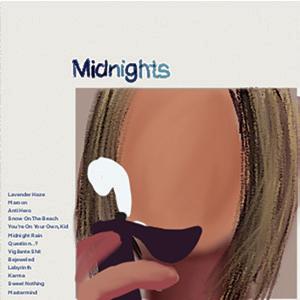
Swift’s latest album, this dreamlike era is an all-encompassing journey through the significant nights of her past as she remembers them. Hits like “Karma” and “Bejeweled” boldly celebrate the triumph of success while tracks like “Maroon” temper that success with contemplation and melancholy. Just like you, the “Midnights” era is full of introspection wrapped in a shimmering appearance.
SPEAK NOW
Entirely self-written, “Speak Now” documents Swift’s blossoming independence and transition from childhood to adulthood. Complemented by a fairytale aesthetic and an upbeat pop-rock sound, the album carries a familiar, confessional vibe on songs like “Enchanted,” “The Story of Us,” and “Back To December.” Unapologetically honest and hauntingly dreamy, the “Speak Now” era is an elegant exercise in knowing when to hold your peace and when to speak (now).


FEARLESS RED LOVER FOLKLORE
Launching Taylor Swift into a world of fame, “Fearless” features hits such as “Love Story” or “Forever & Always,” which the 2021 Taylor’s Version added to with tracks such as “Mr. Perfectly Fine” and “That’s When.” Like its name implies, the starry-eyed “Fearless” era means you embody the courage necessary to live life and pursue what’s meaningful even when faced with failure and heartbreak. Swift’s eponymous first album, this record is innocent and sweet but feisty, befitting her country roots. Though tracks like “Picture To Burn” and “Should’ve Said No” show a fiercer side, Taylor Swift’s Debut era is defined by songs like “Teardrops On My Guitar” and “Our Song,” which encapsulates the hopefulness and kindness of someone who is just starting out and still falling in love with the world.
Swift’s only ‘true’ heartbreak album, “Red” is an era for those currently exploring and coming to terms with complex feelings. Songs like “Red” and “All Too Well” illustrate the messy, raw, intense, and heartfelt process of accepting love and loss, while Taylor’s Version vault tracks like “Nothing New” and “Forever Winter” add even more nuance to the iconic era.

Described as a “love letter to love,” “Lover” details the many lenses through which the idea of ‘love’ can be looked at, from politics to personal life. Quirky and outspoken, the album is rife with emotional intimacy on tracks like “Cruel Summer,” “The Archer” and “Cornelia Street.” Simultaneously joyful and sorrowful, subtle and intense, the “Lover” era is a celebration of love in all its forms.



Amidst the loneliness of the COVID-19 pandemic, Swift entered her whimsical “folklore” era. Billed as a collection of fictional tales in song form, this album is a contemplative reflection of the stories found in the world around us. Songs like “cardigan,” “august,” and “illicit affairs” feature themes of escapism, romanticism, and nostalgia, while the album’s emotional range and storytelling lends “folklore” era an essence of gleaming authenticity.
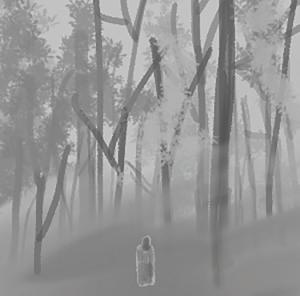
EVERMORE
Though they share the same escapist concept, “evermore” is bolder than sister album “folklore” in its poetic portrayals of the complexities of human connection, which are explored in songs like “willow,” “champagne problems,” and “ivy.” “evermore” era also heavily incorporates nature imagery, channeling the cottage-core aesthetic and enhancing the intimate, genuine feel of the album.
1989
MUSIC • 43





 Croissant Connoisseurs
Croissant Connoisseurs

 By McKenna Rausch, Milena Rodriguez and Jasmine Tabrizi
By McKenna Rausch, Milena Rodriguez and Jasmine Tabrizi


















 Text and design by MILENA RODRIGUEZ and JASMINE TABRIZI • Art by KELLYN SCHEEL • Photos by MILENA RODRIGUEZ
Text and design by MILENA RODRIGUEZ and JASMINE TABRIZI • Art by KELLYN SCHEEL • Photos by MILENA RODRIGUEZ

























































































































 Text and design by ESTHER CHUNG and MARTINA MEYERFREUND • Photo by ESTHER CHUNG
Text and design by ESTHER CHUNG and MARTINA MEYERFREUND • Photo by ESTHER CHUNG






















 Text and design by MIYA JOSHI and JAKE PAPP • Art by SABELA CHELBA and MIYA JOSHI
Text and design by MIYA JOSHI and JAKE PAPP • Art by SABELA CHELBA and MIYA JOSHI









 LI
LI










 Kylie Tzeng
Uri
Ponte
Olivia Hau
Eunchae Hong
Milena
Rodriguez
Kaila Chun
Julie Huang
Kylie Tzeng
Uri
Ponte
Olivia Hau
Eunchae Hong
Milena
Rodriguez
Kaila Chun
Julie Huang


























 Evie Coulson
Jasmine Tabrizi
RosenblumElla
Kellyn Scheel
willow Steele
Casey Walters
Caitlyn Oda
Evie Coulson
Jasmine Tabrizi
RosenblumElla
Kellyn Scheel
willow Steele
Casey Walters
Caitlyn Oda










